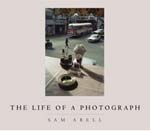The Life of a Photograph
 The Life of a Photograph is a new National Geographic book by photographer Sam Abell. Drawing on 40 years of Abell’s fieldwork, the book takes readers on assignment and inside the heart of this master photographer to witness the making of nearly 200 images. Many photographs are complemented by text from Abell, providing background on the photograph and how he crafted the image. The Life of a Photograph will be available at the end of October for $40.
The Life of a Photograph is a new National Geographic book by photographer Sam Abell. Drawing on 40 years of Abell’s fieldwork, the book takes readers on assignment and inside the heart of this master photographer to witness the making of nearly 200 images. Many photographs are complemented by text from Abell, providing background on the photograph and how he crafted the image. The Life of a Photograph will be available at the end of October for $40.
THE LIFE OF A PHOTOGRAPH
Sam Abell Offers Master Class in Photography with Powerful Images
In THE LIFE OF A PHOTOGRAPH (National Geographic Books; ISBN 978-1-4262-0329-9; Oct. 21, 2008; $40), Sam Abell, one of the foremost photographers of our time, shares some of his most powerful and unforgettable images and answers the question, “What gives life to a photograph?”
Drawing on 40 years of Abell’s fieldwork, the book takes readers on assignment and inside the heart of this master photographer to witness the making of nearly 200 truly great images. Abell has selected photographs that speak most powerfully to him. They include notable images that he has made for National Geographic magazine and books, as well as photographs from his personal body of work that are published here for the first time.
THE LIFE OF A PHOTOGRAPH is organized around Abell’s perspectives on landscape, still life, street scenes and the photography of daily life. Selections cover geography and wildlife from the Arctic to the Amazon, and cultures from Australia to the American West.
In an original concept for a photography book, images are displayed in a unique, highly involving way that allows the viewer to be engaged in the photographic process. By showing similar images side by side, or sequences of photographs of the same event, the viewer is placed in the field and in the editor’s chair. Displaying images in this way allows the viewer to see how a setting appears before the subject enters, like an actor on a stage, and how subtle differences in point of view, framing, timing and perspective can lead to strikingly different photographs.
By presenting alternative images and clear, compelling text, Abell describes that act of seeking the picture — “a process with no absolute ending, as time and thought continue to shape the life of a photograph.”
With each image Abell presents a master class in photographic thinking. Through his lens, even the most mundane sights — a puddle of water, a bathroom faucet, a circle of laundry drying on the line, a plate of baked beans and toast — are transformed into artful, meaningful creations. Many photographs are complemented by text from Abell, providing background on the photograph and how he crafted the image.
“As a photographer my intent is to bring the world under my aesthetic control,” he writes. “Making a picture just right takes time even when the thing you’re photographing isn’t moving. Instead you do the moving — closer, not so close, change lenses, commit to a tripod, micro compose some detail, step back, reconsider, recompose, step back. And when it looks right, it also feels right — just so. Therefore it’s not only things that have made their way into my photography, but also the poetics of them in their setting.”
THE LIFE OF A PHOTOGRAPH is part of National Geographic Books’ new Focal Point imprint, which draws on National Geographic’s legendary photographic archive of more than 10 million images and the work of distinguished photographers around the world. The imprint will present the finest in documentary photography past and present, and monographs will celebrate individual photographers’ unique style, vision and skill.
Abell, who learned his craft from his father Thad S. Abell, has photographed for National Geographic magazine for almost 40 years. He is the author of the National Geographic book “Seeing Gardens” as well as “Stay this Moment,” a mid-career retrospective accompanied by an exhibition at the International Center of Photography, New York. His retrospective “Sam Abell: The Photographic Life” was accompanied by a traveling exhibition that opened at the University of Virginia Art Museum. Abell also collaborated with Stephen Ambrose on two best-selling National Geographic books, “Lewis and Clark: Voyage of Discovery” and “The Mississippi River.”

Loading comments…